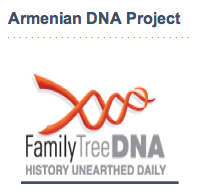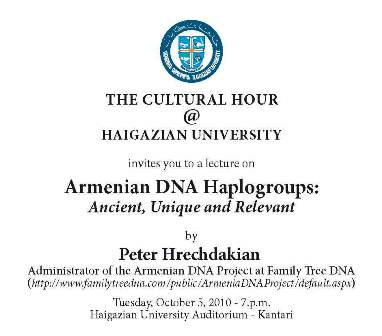
 Azad-Hye Special
Azad-Hye Special
Interview with Peter Hrechdakian, Administrator of the Armenian DNA Project at Family Tree DNA.
What is the basic idea behind the Armenian DNA Project?
The Armenian DNA Project is a crucial resource for Armenians researching their family history and their deep ancestry through genetic testing.
Our project has two complementary sets of goals:
(1) Understand the genetic makeup and deep genetic history of the Armenian people. In the process, we hope to make sense of the historical impact of population migrations, invasions and expansions. By reaching thousands of years into the past, this project also aims to find genetic traces of both the ancient peoples whose descendants make up the current Armenian population (Armens, Colchians, Hattians, Hayasa, Hayk, Hittites, Hurrians, Kaskians, Luwians, Mitanni, Mushkis, Pala, Phrygians, Urartians, etc.) and the ancient invaders who conquered or passed through the Armenian lands (Assyrians, Gamrik-Gimirri-Cimmerians, Galatian Celts, Greeks, Parthians, Romans, Scythians, Macedonians, Medes, Persians, etc.)
(2) Provide a tool for genealogists to trace their recent Armenian ancestors, augmenting historical documentation (primarily from countries of the diaspora – ship lists, censuses, naturalization records, vital records, etc.) and oral traditions. Descendants of known diaspora Armenians who were scattered all over the world in the past centuries might rediscover their roots. Descendants of Genocide orphans may be able to find long lost relatives. Descendants of Armenian families which became separated during and after World War I can have a way of finding each other at long last.
Members need to test their Y-chromosome DNA to determine their paternal lineage and their mitochondrial DNA to determine their maternal lineage.
Once members get their results they find their place in these “trees” of humanity:
http://www.arslanmb.org/ArmenianDNAProject/screenshot-06.jpg and
http://www.arslanmb.org/ArmenianDNAProject/screenshot-05.jpg
By analysing the results of all Armenians tested we get an idea of the branches to which they belong:
ArmenianDNAProject-yDNADistribution
and ArmenianDNAProject-mtDNADistribution.
The challenge afterwards is to tie each branch to a specific people at a specific time in the distant past and in a specific geographical place.
To understand how this works, you should look at these short animated tutorials:
Introduction to Molecular Genealogy
Four Types of DNA
Y-Chromosome DNA (Y-DNA)
Mitochondrial DNA (mtDNA)
Mutations, haplotypes and haplogroups
When the project was initiated and how it developed until today?
The project was launched exactly one year ago, on 12 September 2009 when I first got involved. Prior to that it existed in a different form as a project created by co-administrator Mark Arslan and focused on Armenians from the Keghi region of historic Armenia.
Our project was meant to bring in one place Armenians who were getting tested out of their own intiative by either Family Tree DNA or the Genographic Project (run by the National Geographic Society). Many other ethnic / geographic groups had long had their own projects… but not us.
The first Armenian who ordered a DNA test did so in March 2002. One got tested in 2004. Sixteen in 2005 (including Mark Arslan). Fourteen in 2006. Nineteen on 2007 (including myself). Twenty three in 2008 (including co-administrator Hovann Simonian), etc.
Until we brought everyone together into our project in September 2009 and started recruiting new members, everyone was on his own… and the DNA analysis we were getting from the testing companies was simplistic or downright wrong. I was told for example that I was Jewish on my paternal side and Russian on my maternal side. A double absurdity.
Who can use the services? Is there a kind of scepticism about the project?
 |
Peter Hrachdakian will meet Middle East Armenian public in Beirut on 05 October 2010 (Haigazian University, 7pm) |
Anyone can use the testing services of Family Tree DNA. Men can order tests of both their paternal and maternal lineages. Women are limited to their maternal lineage since they do not have a Y-chromosome. Price is often the major impediment as the worthwhile tests cost more than $100 each at a minimum.
The scepticism about the project has been from people who have privacy concerns about their DNA results. These are easily addressed. Some from the older generation fear they might turn out to be of Turkic descent – something which have not yet found, either in our project or in the broader academic research on Armenian DNA.
DNA studies are based on sound science. Results come in the form of STR marker values and SNP mutations. They are as objective as can be. Subjectivity comes in the interpretation of the results and in the extrapolations many people are tempted to make.
Practically how many persons used the services since it was established?
As of today, 352 DNA kits have been sent out. 283 kits have been returned. 211 paternal Y-DNA results and 92 maternal mtDNA results have been published on our public website.
Some well known Armenian historians, writers, musicians and politicians have been tested as well as various families of Meliks from Karabagh and Syunik, plus members of the Orbelian, Arghutian and Enikolobian, etc.
Can the project develop more?
It most certainly can. We have barely scratched the surface of Armenian DNA. There are many undiscovered branches in the Armenian DNA tree, particularly on the maternal side. We aim to have 1,000 members by the end of 2011. Our growth has been by word-of-mouth so far. We have not yet publicized our project.
Our effort is built on individuals ordering tests out of their own intiative and then bringing them together in one place: the Armenian DNA Project. In parallel, there are some large scale academic studies of Armenian DNA in the works by the likes of Levon Yepiskoposyan, Alain Hovnanian, Pierre Zalloua, Richard Villems, etc… Many of these studies will be published sometime in early 2011. They concern hundreds of Armenians. Unlike our project, participants in these studies do not have direct access to their DNA results – they can only read the overall study once it is published. The only academic paper solely devoted to Armenians is now dated. It was published in 2001 by Michael Weale, Levon Yepiskoposyan, et al.
What new aspects can be added in the future?
As more Armenians join the bandwagon, new aspects of DNA testing open up for them.
One example is the study of autosomal DNA as explained here: Autosomal DNA. It could help Armenians find relatives who are not necessarily from their direct paternal or maternal lineages. A few of our members ordered a product called Family Finder at Family Tree DNA. A larger number of Armenians ordered a similar product called Relative Finder at another DNA testing company, 23andMe. In both instances people tested have been able to find previously unknown Armenian relatives.
Peter Hrechdakian' email address: kaylig(at)skynet.be
The three administrators of the Armenian DNA Project (Mark Arslan, Peter Hrechdakian and Hovann Simonian) are all unpaid volunteers who run this project in their spare time.
Project Leadership
MARK ARSLAN (Volunteer Administrator). Mark, age 53, is an amateur genealogist who has been pursuing this hobby for over 40 years. He is one-fourth Armenian, through his paternal grandfather, Dikran Arslanian, who came to the USA from Keghi, Erzeroum in 1906. Mark hosts 19 family genealogy sites on the Internet and administers 11 surname or geographical DNA projects. He compiled a database of 2,690 immigration entries for Armenians from Keghi entering the USA through Ellis Island (New York): link. Mark has a Bachelor of Science degree in Forestry from Oregon State University (Corvallis, Oregon, USA) and has been employed by IBM Corporation for over 30 years, where he is currently in technical sales. Mark and his wife, two sons, and a daughter live in North Carolina, USA.
PETER HRECHDAKIAN (Volunteer Administrator). Peter, age 51, wants to uncover the deep ancestry of the Armenian people through archaeogenetics. Born in Aleppo to a father from Urfa and a mother from Aintab, he grew up in Lebanon before emigrating to the USA in 1975. Peter wants to piece together information from genetics, history, anthropology, linguistics, archeology and genealogy to uncover the make-up of the ancestral populations of Anatolia, the Armenian plateau and the Caucasus from which the Armenian people arose. Using the latest genetic tools, he wants to understand how the diverse Armenian genetic pool was affected by broad historical processes such as invasions, migrations, wars, forced population transfers, natural catastrophes, etc. and also subtle historical processes such as admixture, conversion, micro-migration… Peter has a Bachelor of Arts degree in Economics and Philosophy from Cornell University (Ithaca, New York) and a Masters in Business Administration degree from Harvard Business School (Boston, Massachussetts). He is the CEO of the Unifert group, a 40 year old privately held international fertilizer trading & distribution company. Peter, his wife, and two daughters live in Brussels, Belgium.
HOVANN SIMONIAN (Volunteer Administrator). Hovann Simonian, age 43, is our expert in Armenian history, historical geography and culture. He believes DNA research can be a useful tool for confirming or subverting key historical narratives and for elucidating some of the mysteries and unresolved questions of Armenian history. Hovann is particularly interested in deep genealogy, the survival of Armenian nobility and the origins of various special Armenian communities (such as Hamshen Armenians or Hemshin, Dersim tribes, Hay-Roums, Levantinized Armenian Catholics of Smyrna, Arabicized Armenians of Syria and Lebanon, Turkified and Kurdified Armenians, etc.). Hovann was born in Beirut to Armenian parents of Sasuntsi and Aintabtsi heritage. He was raised in Switzerland where his family moved at the beginning of the Civil War in Lebanon in 1975. He holds a Licence en Sciences Economiques et Sociales from the school of Hautes Etudes Commerciales (HEC) of the University of Lausanne (1988), an MA in International Relations from the Department of Political Science at the University of Southern California (1996), and another MA in Central Asian Studies from the Center for Near and Middle Eastern Studies at the School of Oriental and African Studies, the University of London (1997). Hovann is currently a PhD candidate in the department of Political Science at the University of Southern California. In addition to various articles and book chapters, he is the co-author of “Troubled Waters: The Geopolitics of the Caspian Region ” (London: I. B. Tauris, 2001/2003) and the editor of “The Hemshin: History, Society and Identity in the Highlands of Northeast Turkey” (London: Routledge, 2007). He is a member of the Executive Council of the Society for Armenian Studies, serving as treasurer of the Society. Hovann lives in Lausanne, Switzerland.

I have taken the simple DNA test this week. I am looking forward to the results and sharing them with other people interested in DNA and genealogy. I have mentioned the project to a few relatives and I hope they and more Armenians will contribute to this fascinating study. I am happy with what ever ancestral outcomes the analyst provide. I admit I do not understand the scientific process. I know I am the sum of many many generations of people who may have traveled all over the world and married with locals of another culture, I think most people will find that in their genealogy. Congratulations to the team for undertaking such a major project!
David R Arathoon
Toronto
Thank you for sending me Azad-Hye news article. It has given me an insight into the Armenian DNA project and where I fit into it. I also welcome the links to explanatory articles etc which are a great help in educating me in some of the basics of (Armenian) genetics. I hope that many others will join the project.
Regards,
Ara Melkonian
Peter, Mark and Hovann; I just want to thank you for all the time, your expertise and effort you are putting into this project.
Bob Sarquis